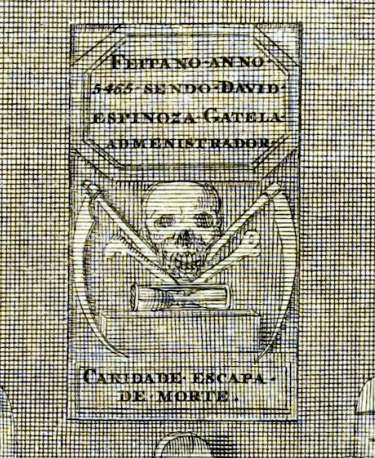An eagle-eyed reader pointed out to me that one of Bernard Picart's engravings in Jean Frederic Bernard's massive Cérémonies et coutumes religieuses de tous les peuples du monde (1723) features the following wall hanging (in a shul ? funeral parlor? the home of the deceased?) in Amsterdam:

The Portuguese sign reads:
Feitano Anno
5465 Sendo David
Espinoza Gatela
Admenistrador
and below the skull is
Caridade Escapa
De Morte
The inscription means "Made in the year 5465 (1705), being David Espinoza Gatela Admenistrador" (readers, help please?).
Incidentally, Espinoza is the same name as Spinoza, the former being how a Spanish or other Iberian language speaker must pronounce a word with an initial consonant cluster, (I think it's called a word-initial epenthesis), analogous to the aleph prostheticum, or prosthetic aleph, in Hebrew and Aramaic, in which certain words require adding an aleph to the beginning for ease of pronunciation. One famous example is, probably, the name Ahaseurus, as well as other Persian names in the Bible, which lacked the initial consonant in the original language. Of course here the opposite is the case: Spanish required Espinoza, but that is the real name - but other European languages did not require it, so it became Spinoza.
Below the spooky skull is Caridade Escapa De Morte, which is of course, צדקה תציל ממות!
The complete image below is small so that it fits here, but please click it for much greater detail. The details of the dress, expressions, etc. are not to be missed!
The French caption is Les Acafoth ou les sept tours, autour Cercueïl, which means The הקפות (using the Western Sephardic transliteration, Acafoth), or seven circuits around the coffin.

Also note the horn book style tablets they're holding for more easily reading whichever prayer it is that they read while engaged in this funerary custom, which is describe in the 1733 English translation as follows:
"After the coffin is nailed down, ten chosen Persons of the most considerable Relations and Friends of the Deceased turn seven Times round the Coffin, and all the Time offer up their Prayers to God for his departed Soul. This is the Practice in Holland, where the Design of the Plate which represents this Ceremony was drawn from the Life."
A big thank you to Mordechai Ovits for solving a technical problem for me, namely grabbing images from a tricky flash viewer (extremely high resolution ones at that).
